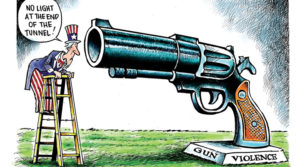Marty Levine
June 8, 2022

Why is our democracy unable to tackle the difficult problems that confront us? Why are we facing today so many of the same challenges we faced a decades ago?
Maybe it is because knowledge matters so little to our policymakers. Our political system rewards fact-free, painless, “Not-In-My-Backyard (NIMBY)” solutions. What we learn as we study problems often challenges what we thought we know and unsettles the status quo. It is politically more expedient, even if less effective, to ignore challenging facts.
Unconvinced? Let’s take a look at the current debate going on over how to respond to gun violence and mass shootings.
Knowledge was so challenging that in 1996 the Federal Government stopped funding research on gun violence and because the Federal Government stopped its research, private funders also stepped back. This anti-knowledge policy was advocated for by the NRA and other conservative powers after the New England Journal of Medicine (NEJM) published an article by Arthur Kellerman and colleagues, “Gun Ownership as a Risk Factor for Homicide in the Home,” “which presented the results of research funded by the Centers for Disease Control and Prevention (CDC). The study found that keeping a gun in the home was strongly and independently associated with an increased risk of homicide. The article concluded that rather than confer protection, guns kept in the home are associated with an increase in the risk of homicide by a family member or intimate acquaintance.”
For more than 2 decades, until 2019, the Federal Government put would not fund the gathering of better information about the factors that made our country the world leader in gun-related injuries and death. The National Cancer Institute has an annual budget that exceeds $6 billion to search for ways to reduce the death toll from a disease, in all of its forms, that results in the death of 600,000 annually. The Federal government, until 2019, would not spend one penny to see how we could reduce the death toll (40,000/year) from gun violence. And when funds for CDC research were restored, it was only $25 million.
Powerful interests wanted to keep the debate over what to do about a national embarrassment fact-free because they feared that facts might be difficult to ignore.
Just look at the current debate taking place in the Senate in the wake of the horrors of Buffalo and Uvalde.
On Sunday the New York Times put some information on the table adding to what we know about gun violence in our country. Using the Violence Project’s database of mass shootings in the United States since 1999, the Times analyzed each mass shooting incident and assessed the potential impact that six different policy options might have had, how they might have changed the course of history and prevented harm.
Here’s what they found looking at six ideas that are now being debated:
- Expanding red-flag laws to remove guns from people in crisis would have had a chance of altering the course of events in 46 percent of the cases.
- If we had continued to ban assault rifles, a ban that was allowed to expire in 1994, 30 percent of the mass shootings might have been avoided because the murderer used such a weapon.
- If we banned large-capacity magazines which give guns the ability to shoot more bullets quicker, 20 percent of the shootings might have been prevented.
- Requiring gun owners to safely store their weapons and punishing them if they do not, might have prevented 10 percent of the shootings.
- Raising the minimum age for buying certain guns to 21 would have changed the case in only 4 of the cases.
- Expanding background checks to include all gun sales would have impacted only 4 cases.
The current debate does not feature a high-minded consideration of our knowledge. It focuses more on the politics of the situation; politics that have an entrenched, head-in-the-sand opposition that refuses to look at any data because they fear it may challenge their biases and the comfort of their base and their funds for whom data is irrelevant and to be feared.
Sen. Chris Murphy described the context of the current debate over gun violence and the need for action in a Sunday interview reported by the Washington Post. “The biggest factor pushing the two parties toward the kind of deal that has been elusive in the past is a collective sense of the cost of failure. I think parents and kids are really scared right now, and for us to let our politics get in the way of providing them an answer, and comfort, would be devastating, But, you know, this is the most politically complicated and emotionally fraught issue that Congress deals with. There’s a reason we haven’t made progress on this for 30 years.”
Data showing that combining red flag laws with a ban on assault-style weapons could have a major impact would, in a fact-driven world, see these be at the top of the list and easy to pass. But that is not how we now govern. While President Biden had them front and center on his list of actions needed when he addressed the nation last week, the legislative process grinding through the House and Senate seems uninterested in this kind of data.
The legislation now under discussion, legislation which must pass the Senate’s self-imposed need for a 60-vote super majority, does not include taking assault weapons or any type of weaponry out of circulation and making them unavailable for purchase. A red flag law is being considered but the likelihood that it will become law seems slim.
Here’s how the Washington Post described the debate. “Sen. Blumenthal said he and Sen. Lindsey O. Graham (R-S.C.) had come to an agreement between the two of them on a basic framework for legislation that would create a system of incentives, grants, and federal standards for states that create their own red-flag laws. But he said details were still being hashed out as the discussion moved to a wider group of bipartisan negotiators…It remained unclear, Blumenthal said, if any iteration of the proposal could garner the necessary 60 votes — which would mean a minimum of 10 Republicans if all 50 members of the Democratic caucus backed a deal. It’s not final until it’s final, and we need 60 votes,” he said. “We’re now going beyond the two of us to 10 of us, and we also need to be mindful of 60 of us, because all of the optimism in the world will fail to save lives unless we make it law.”
The reality of any effort to change societal dynamics is that there are no magic bullets or golden tickets that, if found, will totally eliminate a societal problem. As Garen Wintemute, the director of the Violence Prevention Research Program at the University of California at Davis told the New York Times, “There’s no such thing as a perfect, 100 percent effective policy or suite of policies. But there is a chance to make a real difference.”
But a real difference is also not enough. Facts can be ignored because they ask for changes that are difficult. They can be attacked because they can be magic bullet solutions and that it will take time to show their impact. A cycle of constant improvement in which policies are changed based on what we learn as we implement them just offers additional opportunities to gum up the works of government. This is what happened after “Obamacare” was enacted. Experience shows us where it worked and where it needed improvement. But rather than recognize this is a natural process of system change, it provided a chance for those fighting against it to renew the battle and ignore the facts of how much it had improved health care. The need for further legislation provided another moment when false arguments and proposals could be used to make governance impossible. Whatever the facts might be, the interests of those who profit from selling guns and benefit from using gun ownership as a wedge issue to control governance are still too strong.

Senate Minority Leader Mitch McConnell clearly has no interest in the facts or the data. Here’s the direction he is setting and which will control the outcome. “What we’re doing is…we have a group led by Senator Cornyn and Senator Murphy on the Democratic side discussing how we might be able to come together to target the problem, which is mental illness and school safety. We’ll get back at it next week and hope to get it resolved.”
We are all responsible for this legislative morass, both conservatives, and progressives. We all try not to hear information that tells us we might be wrong, that our pet policy directions might not work. We all seize on the lack of immediate impact for ideas we do not support as reasons to abandon their direction. We will not be governed well if we are not willing to accept that data means something even when it shows us that to fix social ills, we will need to give something up. We will need to allow our communities, our neighborhoods, our workplaces, and our schools to become different and, perhaps, less comfortable, if we are to have any hope for a society that works better than ours does today.
Are you willing to join me in paying that price? Are you willing to elect officials who share that view?
